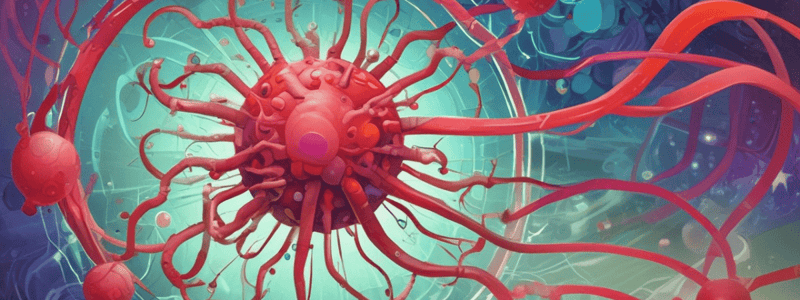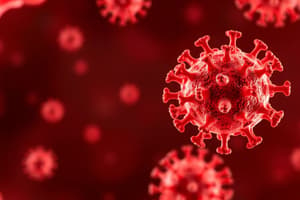Podcast
Questions and Answers
What is the primary target of HIV infection?
What is the primary target of HIV infection?
- Neutrophils
- B cells
- CD4+ T cells (correct)
- CD8+ T cells
What is the result of the integration step in HIV replication?
What is the result of the integration step in HIV replication?
- Viral RNA is translated into proteins
- Viral DNA is transcribed into RNA
- Viral DNA is integrated into the host cell genome (correct)
- Viral RNA is converted to DNA
How does HIV evade the immune system?
How does HIV evade the immune system?
- By downregulating MHC-I expression (correct)
- By producing immune stimulatory proteins
- By upregulating CD4 receptors
- By increasing the production of cytokines
What is a characteristic of immune system dysfunction in HIV infection?
What is a characteristic of immune system dysfunction in HIV infection?
Which of the following is NOT an opportunistic infection associated with HIV?
Which of the following is NOT an opportunistic infection associated with HIV?
What is the result of the transcription step in HIV replication?
What is the result of the transcription step in HIV replication?
What is the net effect of HIV infection on CD4+ T cell counts?
What is the net effect of HIV infection on CD4+ T cell counts?
What is the primary mechanism by which HIV infects CD4+ T cells?
What is the primary mechanism by which HIV infects CD4+ T cells?
What is a characteristic of acute HIV infection?
What is a characteristic of acute HIV infection?
What is the primary difference between chronic HIV infection and AIDS?
What is the primary difference between chronic HIV infection and AIDS?
Which of the following is a complication of HIV infection?
Which of the following is a complication of HIV infection?
What is the primary function of CD4+ T cells?
What is the primary function of CD4+ T cells?
What is the primary consequence of HIV infection on the immune system?
What is the primary consequence of HIV infection on the immune system?
Which of the following is an AIDS-defining illness?
Which of the following is an AIDS-defining illness?
What is the primary reason why HIV patients are susceptible to opportunistic infections?
What is the primary reason why HIV patients are susceptible to opportunistic infections?
What is the primary consequence of HIV infection on the body?
What is the primary consequence of HIV infection on the body?
Flashcards are hidden until you start studying
Study Notes
Viral Structure and Replication
- HIV (Human Immunodeficiency Virus) is a retrovirus that targets CD4+ T cells, macrophages, and dendritic cells.
- The virus consists of two single-stranded RNA molecules, a protein core, and a lipid envelope.
- HIV replication involves:
- Binding: gp120 protein binds to CD4 receptors and co-receptors on host cells.
- Fusion: gp41 protein mediates fusion of the viral and host cell membranes.
- Reverse transcription: viral RNA is converted to DNA by reverse transcriptase.
- Integration: viral DNA is integrated into the host cell genome.
- Transcription: viral DNA is transcribed into RNA.
- Translation: viral RNA is translated into proteins.
- Assembly: new viral particles are assembled.
- Budding: mature viral particles are released from the host cell.
Immune System Evasion
- HIV evades the immune system by:
- Rapidly mutating its surface proteins to avoid recognition by the immune system.
- Downregulating MHC-I expression to avoid recognition by cytotoxic T cells.
- Producing immune suppressive proteins (e.g., Nef).
- Infecting and killing immune cells (e.g., CD4+ T cells).
CD4+ T Cell Depletion
- HIV infection leads to a decline in CD4+ T cell counts, impairing cell-mediated immunity.
- CD4+ T cells are depleted through:
- Direct viral killing.
- Immune-mediated killing (e.g., cytotoxic T cells, antibody-dependent cellular cytotoxicity).
- Activation-induced cell death (AICD).
Immune System Dysfunction
- HIV infection leads to immune system dysfunction, characterized by:
- Chronic immune activation.
- Inflammation.
- Immune exhaustion.
- Disrupted cytokine balance.
- Impaired immune responses to opportunistic infections.
Opportunistic Infections
- Opportunistic infections occur due to impaired immune function, including:
- Pneumocystis pneumonia (PCP).
- Toxoplasmosis.
- Tuberculosis.
- Cryptococcal meningitis.
- Candidiasis.
AIDS Definition
- AIDS (Acquired Immune Deficiency Syndrome) is defined by:
- CD4+ T cell count < 200 cells/μL.
- Presence of certain opportunistic infections or cancers.
- Severe symptoms, such as wasting syndrome or HIV-associated dementia.
Viral Structure and Replication
- HIV is a retrovirus that targets CD4+ T cells, macrophages, and dendritic cells.
- The virus consists of two single-stranded RNA molecules, a protein core, and a lipid envelope.
- HIV replication involves binding of gp120 protein to CD4 receptors and co-receptors on host cells.
- Fusion of the viral and host cell membranes is mediated by gp41 protein.
- Viral RNA is converted to DNA by reverse transcriptase during reverse transcription.
- Viral DNA is integrated into the host cell genome.
- Viral DNA is transcribed into RNA, and then translated into proteins.
- New viral particles are assembled, and mature viral particles are released from the host cell through budding.
Immune System Evasion
- HIV evades the immune system by rapidly mutating its surface proteins.
- HIV downregulates MHC-I expression to avoid recognition by cytotoxic T cells.
- Immune suppressive proteins, such as Nef, are produced by HIV.
- HIV infects and kills immune cells, including CD4+ T cells.
CD4+ T Cell Depletion
- HIV infection leads to a decline in CD4+ T cell counts, impairing cell-mediated immunity.
- CD4+ T cells are depleted through direct viral killing.
- Immune-mediated killing, such as by cytotoxic T cells and antibody-dependent cellular cytotoxicity, deplete CD4+ T cells.
- Activation-induced cell death (AICD) also contributes to CD4+ T cell depletion.
Immune System Dysfunction
- HIV infection leads to chronic immune activation.
- Inflammation occurs as a result of HIV infection.
- Immune exhaustion is a characteristic of HIV infection.
- Disrupted cytokine balance is a result of HIV infection.
- Immune responses to opportunistic infections are impaired.
Opportunistic Infections
- Pneumocystis pneumonia (PCP) is an opportunistic infection that occurs due to impaired immune function.
- Toxoplasmosis is another opportunistic infection that occurs in HIV-infected individuals.
- Tuberculosis, cryptococcal meningitis, and candidiasis are also opportunistic infections that occur in HIV-infected individuals.
AIDS Definition
- AIDS is defined by a CD4+ T cell count of less than 200 cells/μL.
- The presence of certain opportunistic infections or cancers is also a defining feature of AIDS.
- Severe symptoms, such as wasting syndrome or HIV-associated dementia, are also characteristic of AIDS.
HIV Infection
- HIV targets CD4+ T cells (T helper cells) and binds to CD4 receptors, fusing with the cell membrane and releasing genetic material into the host cell
- HIV replicates within the host cell, producing new viral particles that can infect other CD4+ T cells
Acute HIV Infection
- Flu-like symptoms occur 2-4 weeks post-infection, including fever, fatigue, and swollen lymph nodes
- Rapid virus replication and significant CD4+ T cell count drop during this stage
- Immune system responds, producing antibodies against HIV, detectable through blood tests
Chronic HIV Infection
- Gradual decline in CD4+ T cell count if left untreated
- Mild symptoms, including fatigue, weight loss, and skin rashes
- Continued virus replication and increased susceptibility to opportunistic infections and illnesses
AIDS (Acquired Immunodeficiency Syndrome)
- Advanced stage of HIV infection, characterized by a severely weakened immune system
- CD4+ T cell count falls below 200 cells/mm³, making patients highly susceptible to opportunistic infections and cancers
- AIDS-defining illnesses include PCP, toxoplasmosis, cryptococcal meningitis, and cancers like Kaposi's sarcoma and lymphoma
Immune System Dysfunction
- Decline in CD4+ T cell count impairs the immune system's ability to fight off infections and diseases
- HIV infection and destruction of other immune cells, such as macrophages and dendritic cells
- Impaired immune function increases the risk of opportunistic infections, cancers, and other illnesses
Complications and Co-Infections
- Increased risk of co-infections, such as tuberculosis, hepatitis, and malaria
- Common complications include HIVAN, cardiovascular disease, and neurological disorders like HIV-associated dementia and peripheral neuropathy
Studying That Suits You
Use AI to generate personalized quizzes and flashcards to suit your learning preferences.




